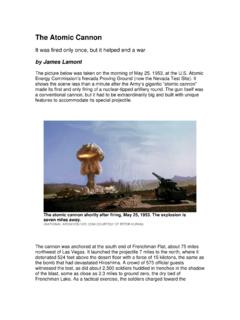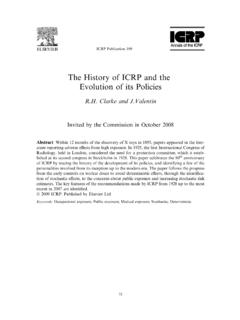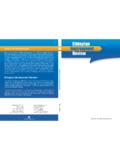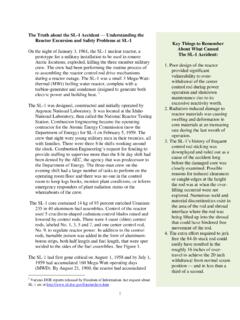Transcription of Brief History of Computer Crime - M. E. Kabay Web …
1 Copyright 2008 M. E. Kabay . All rights reserved Page 1 of 51 A Brief History of Computer Crime : An Introduction for Students M. E. Kabay , PhD, CISSP-ISSMP Program Director, MSIA School of Graduate Studies Norwich University Contents WHY STUDY HISTORICAL RECORDS? .. 3 OVERVIEW .. 4 1960s & 1970s: SABOTAGE .. 5 Direct Damage to Computer Centers .. 5 1970-1972: Albert the Saboteur .. 7 IMPERSONATION .. 9 1970: Jerry Neal Schneider .. 9 1980-2003: Kevin Mitnick .. 9 Credit Card Fraud .. 11 Identity Theft Rises .. 13 PHONE PHREAKING .. 14 2600 Hz .. 14 1982-1991: Kevin Poulsen .. 15 DATA DIDDLING .. 17 The Equity Funding Fraud (1964-1973) .. 17 1994: Vladimir Levin and the Citibank Heist .. 18 SALAMI FRAUD .. 19 LOGIC BOMBS .. 20 EXTORTION.
2 22 TROJAN HORSES .. 23 The 1988 Flu-Shot Hoax .. 23 Scrambler, 12-Tricks and PC Cyborg .. 23 1994: Datacomp Hardware Trojan .. 23 A Brief History of Computer Crime Copyright 2008 M. E. Kabay . All rights reserved Page 2 of 51 Keylogger Trojans .. 24 The Haephrati 25 Hardware Trojans and Information Warfare .. 27 NOTORIOUS WORMS AND VIRUSES .. 28 1970-1990: Early Malware Outbreaks .. 28 November 2, 1988: The Morris Worm .. 29 Malware in the 1990s .. 31 March 1999: Melissa .. 34 May 2000: I LOVE YOU .. 35 SPAM .. 36 1994: The Green Card Lottery Spam .. 36 Spam Goes Global .. 37 DENIAL OF SERVICE .. 38 1996: The Unamailer .. 38 2000: Mafia Boy .. 39 THE HACKER UNDERGROUND OF THE 1980s & 1990s .. 41 1981: Chaos Computer Club .. 41 1982: The 414s.
3 42 1984: Cult of the Dead Cow .. 42 1984: 2600: The Hacker Quarterly .. 43 1984: Legion of Doom .. 43 1985: Phrack .. 45 1989: Masters of Deception (MOD) .. 46 1990: Operation Sundevil .. 46 1990: Steve Jackson Games .. 47 1992: L0pht Heavy Industries .. 48 2004: Shadowcrew .. 49 CONCLUDING REMARKS .. 50 FOR FURTHER READING .. 51 A Brief History of Computer Crime Copyright 2008 M. E. Kabay . All rights reserved Page 3 of 51 WHY STUDY HISTORICAL RECORDS? Every field of study and expertise develops a common body of knowledge that distinguishes professionals from One element of that body of knowledge is a shared History of significant events that have shaped the development of the field. Newcomers to the field benefit from learning the names and significant events associated with their field so that they can understand references from more senior people in the profession and so that they can put new events and patterns into perspective.
4 This paper provides a Brief overview of some of the more famous (or notorious) cases of Computer Crime (including those targeting computers and those mediated through computers) of the last four 1 This paper was written with the intention of serving students in the IS340 Introduction to Information Assurance, IS342 Management of Information Assurance and CJ341 Cyberlaw and Cybercrime courses at Norwich University. A later version was used as Chapter 2, History of Computer Crime , in Bosworth, S., M. E. Kabay and E. Whyne (2009), eds. Computer Security Handbook, 5th Edition, Volume I. New York: Wiley. 2 Some of the materials in this paper use text from the author s prior publications to which he holds the copyright. However, specific attributions or quotation marks in such cases are generally avoided because changes are extensive and the typographical notations marking the changes would have been intrusive and disruptive.
5 A Brief History of Computer Crime Copyright 2008 M. E. Kabay . All rights reserved Page 4 of 51 OVERVIEW This paper will illustrate several general trends from the 1960s through the decade following 2000: In the early decades of modern information technology (IT), Computer crimes were largely committed by individual disgruntled and dishonest employees. Physical damage to Computer systems was a prominent threat until the 1980s. Criminals often used authorized access to subvert security systems as they modified data for financial gain or destroyed data for revenge. Early attacks on telecommunications systems in the 1960s led to subversion of the long-distance phone systems for amusement and for theft of services. As telecommunications technology spread throughout the IT world, hobbyists with criminal tendencies learned to penetrate systems and networks.
6 Programmers in the 1980s began writing malicious software, including self-replicating programs, to interfere with personal computers. As the Internet increased access to increasing numbers of systems worldwide, criminals used unauthorized access to poorly protected systems for vandalism, political action and financial gain. As the 1990s progressed, financial Crime using penetration and subversion of Computer systems increased. The types of malware shifted during the 1990s, taking advantage of new vulnerabilities and dying out as operating systems were strengthened, only to succumb to new attack vectors. Illegitimate applications of e-mail grew rapidly from the mid-1990s onward, generating torrents of unsolicited commercial and fraudulent e-mail. A Brief History of Computer Crime Copyright 2008 M.
7 E. Kabay . All rights reserved Page 5 of 51 1960s & 1970s: SABOTAGE Early Computer crimes often involved physical damage to Computer systems and subversion of the long-distance telephone networks. Direct Damage to Computer Centers In February 1969, the largest student riot in Canada was set off when police were called in to put an end to a student occupation of several floors of the Hall Building. The students had been protesting against a professor accused of racism, and when the police came in, a fire broke out and Computer data and university property were destroyed. The damages totalled $2 million, and 97 people were Thomas Whiteside cataloged a litany of early physical attacks on Computer systems in the 1960s and 1970s:4 1968, Olympia, WA: an IBM 1401 in the state is shot twice by a pistol toting intruder 1970, University of Wisconsin: bomb kills one and injures three people and destroys $16 million of Computer data stored on site 1970, Fresno State College: Molotov cocktail causes $1 million damage to Computer system 1970, New York University: radical students place fire-bombs on top of Atomic Energy Commission Computer in attempt to free a jailed Black Panther 1972, Johannesburg, South Africa: municipal Computer dented by four bullets fired through a window 1972, New York.
8 Magnetic core in Honeywell Computer attacked by someone with a sharp instrument, causing $589,000 of damage 1973, Melbourne, Australia: antiwar protesters shoot American firm s Computer with double-barreled shotgun 1974, Charlotte, NC: Charlotte Liberty Mutual Life Insurance Company Computer shot by a frustrated operator 3 Concordia University (2008). Who we are: History . 4 Whiteside, T. (1978). Computer Capers: Tales of Electronic Thievery, Embezzlement, and Fraud. New York: New American Library A Brief History of Computer Crime Copyright 2008 M. E. Kabay . All rights reserved Page 6 of 51 1974, Wright Patterson Air Force Base: four attempts to sabotage computers, including magnets, loosened wires, and gouges in equipment 1977, Rome: four terrorists pour gasoline on university Computer and burn it to cinders 1978, Vandenburg Air Force Base, California: a peace activist destroys an unused IBM 3031 using a hammer, a crowbar, a bolt cutter and a cordless power drill as a protest against the NAVSTAR satellite navigation system, claiming it gives the US a first-strike capability The incidents of physical abuse of Computer systems did not stop as other forms of Computer Crime increased.
9 For example, in 2001, NewsScan editors5 summarized a report from Wired Magazine as follows: A survey by British PC maker Novatech, intended to take a lighthearted look at techno-glitches, instead revealed the darker side of computing. One in every four computers has been physically assaulted by its owner, according to the 4,200 In April 2003, the National Information Protection Center and Department of Homeland Security reported Nothing brings a network to a halt more easily and quickly than physical damage. Yet as data transmission becomes the lifeblood of Corporate America, most big companies haven t performed due diligence to determine how damage-proof their data lifelines really are. Only 20% of midsize and large companies have seriously sussed out what happens to their data connections after they go beyond the company firewall, says Peter Salus of MatrixNetSystems, a network-optimization company based in Austin, 5 Gehl, J.
10 And S. Douglas (2001). Survey reveals epidemic of battered PCs. NewsScan (Jun 5, 2001) 6 Delio, M. (2001). Battered Computers: An Epidemic. Wired (June 5, 2001). 7 NIPC/DHS (2003). Physical attack still the biggest threat. Daily Open-Source Threat Report (April 11, 2003) A Brief History of Computer Crime Copyright 2008 M. E. Kabay . All rights reserved Page 7 of 51 By the mid-2000s, concerns over the physical security of electronic voting systems had risen to public awareness. For example, A cart of Diebold electronic voting machines was delivered today to the common room of this Berkeley, CA boarding house, which will be a polling place on Tuesday s primary election. The machines are on a cart which is wrapped in plastic wrap (the same as the stuff we use in the kitchen).





